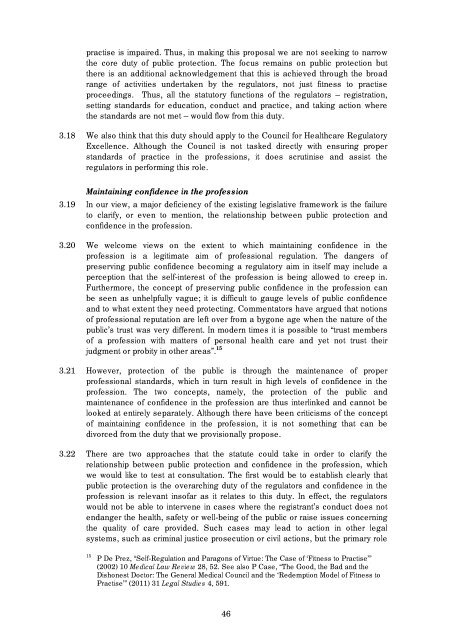Regulation of Health and Social Care Professionals Consultation
Regulation of Health and Social Care Professionals Consultation
Regulation of Health and Social Care Professionals Consultation
Create successful ePaper yourself
Turn your PDF publications into a flip-book with our unique Google optimized e-Paper software.
practise is impaired. Thus, in making this proposal we are not seeking to narrow<br />
the core duty <strong>of</strong> public protection. The focus remains on public protection but<br />
there is an additional acknowledgement that this is achieved through the broad<br />
range <strong>of</strong> activities undertaken by the regulators, not just fitness to practise<br />
proceedings. Thus, all the statutory functions <strong>of</strong> the regulators – registration,<br />
setting st<strong>and</strong>ards for education, conduct <strong>and</strong> practice, <strong>and</strong> taking action where<br />
the st<strong>and</strong>ards are not met – would flow from this duty.<br />
3.18 We also think that this duty should apply to the Council for <strong>Health</strong>care Regulatory<br />
Excellence. Although the Council is not tasked directly with ensuring proper<br />
st<strong>and</strong>ards <strong>of</strong> practice in the pr<strong>of</strong>essions, it does scrutinise <strong>and</strong> assist the<br />
regulators in performing this role.<br />
Maintaining confidence in the pr<strong>of</strong>ession<br />
3.19 In our view, a major deficiency <strong>of</strong> the existing legislative framework is the failure<br />
to clarify, or even to mention, the relationship between public protection <strong>and</strong><br />
confidence in the pr<strong>of</strong>ession.<br />
3.20 We welcome views on the extent to which maintaining confidence in the<br />
pr<strong>of</strong>ession is a legitimate aim <strong>of</strong> pr<strong>of</strong>essional regulation. The dangers <strong>of</strong><br />
preserving public confidence becoming a regulatory aim in itself may include a<br />
perception that the self-interest <strong>of</strong> the pr<strong>of</strong>ession is being allowed to creep in.<br />
Furthermore, the concept <strong>of</strong> preserving public confidence in the pr<strong>of</strong>ession can<br />
be seen as unhelpfully vague; it is difficult to gauge levels <strong>of</strong> public confidence<br />
<strong>and</strong> to what extent they need protecting. Commentators have argued that notions<br />
<strong>of</strong> pr<strong>of</strong>essional reputation are left over from a bygone age when the nature <strong>of</strong> the<br />
public’s trust was very different. In modern times it is possible to “trust members<br />
<strong>of</strong> a pr<strong>of</strong>ession with matters <strong>of</strong> personal health care <strong>and</strong> yet not trust their<br />
judgment or probity in other areas”. 15<br />
3.21 However, protection <strong>of</strong> the public is through the maintenance <strong>of</strong> proper<br />
pr<strong>of</strong>essional st<strong>and</strong>ards, which in turn result in high levels <strong>of</strong> confidence in the<br />
pr<strong>of</strong>ession. The two concepts, namely, the protection <strong>of</strong> the public <strong>and</strong><br />
maintenance <strong>of</strong> confidence in the pr<strong>of</strong>ession are thus interlinked <strong>and</strong> cannot be<br />
looked at entirely separately. Although there have been criticisms <strong>of</strong> the concept<br />
<strong>of</strong> maintaining confidence in the pr<strong>of</strong>ession, it is not something that can be<br />
divorced from the duty that we provisionally propose.<br />
3.22 There are two approaches that the statute could take in order to clarify the<br />
relationship between public protection <strong>and</strong> confidence in the pr<strong>of</strong>ession, which<br />
we would like to test at consultation. The first would be to establish clearly that<br />
public protection is the overarching duty <strong>of</strong> the regulators <strong>and</strong> confidence in the<br />
pr<strong>of</strong>ession is relevant ins<strong>of</strong>ar as it relates to this duty. In effect, the regulators<br />
would not be able to intervene in cases where the registrant’s conduct does not<br />
endanger the health, safety or well-being <strong>of</strong> the public or raise issues concerning<br />
the quality <strong>of</strong> care provided. Such cases may lead to action in other legal<br />
systems, such as criminal justice prosecution or civil actions, but the primary role<br />
15 P De Prez, “Self-<strong>Regulation</strong> <strong>and</strong> Paragons <strong>of</strong> Virtue: The Case <strong>of</strong> ‘Fitness to Practise’”<br />
(2002) 10 Medical Law Review 28, 52. See also P Case, “The Good, the Bad <strong>and</strong> the<br />
Dishonest Doctor: The General Medical Council <strong>and</strong> the ‘Redemption Model <strong>of</strong> Fitness to<br />
Practise’” (2011) 31 Legal Studies 4, 591.<br />
46
















